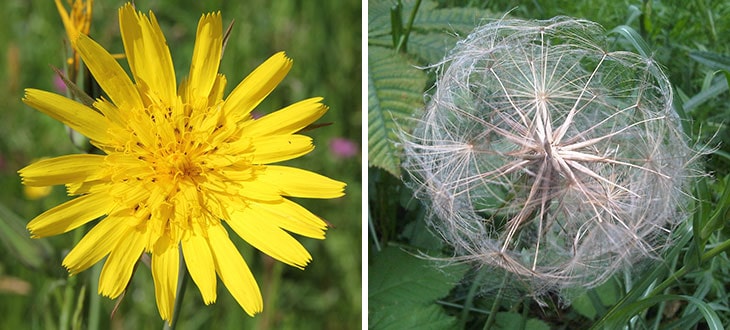Salsifies – Giant Dandelions Or Different Plants?
Have you stumbled upon a wild plant that looks like a giant dandelion? You most likely encountered salsify, a plant that has flower heads similar in appearance to those of dandelions, but considerably larger.
Many refer to them as giant dandelions because of their large flower heads that look similar to those of dandelions. However, despite their resemblances in flowers and the fact that they belong to the same botanical family, Asteraceae, dandelions and salsifies are two distinct plants.
Salsify is a flowering plant in the Asteraceae family (daisy family), the genus Tragopogon. This group comprises multiple species which are generally known under names like salsify, goatsbeard, oyster plant, vegetable oyster, and several other more specific for each species.
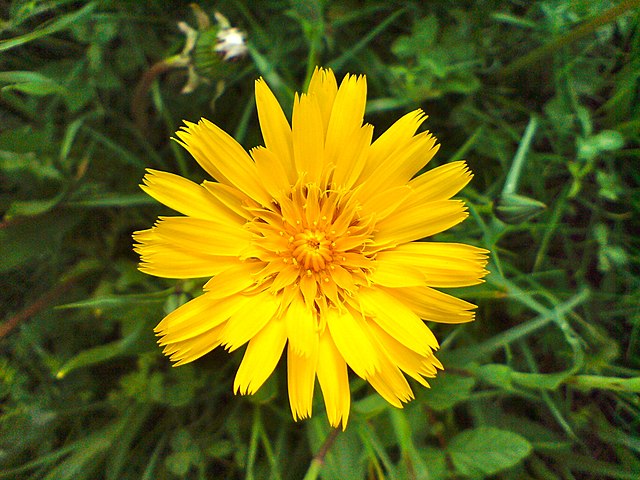
These plants are predominantly native to Eurasia and were over time introduced to many other countries as garden or ornamental plants, including in North America.
Salsifies prosper in a wide range of soil types. They are oftentimes found growing in disturbed areas, pastures, meadows, waste areas, grasslands, roadsides, shrublands, woodlands, open forests, railroads, and so on.
Depending on the species, climate, and purpose, the salsify plants grow either as annuals, biennials, or monocarpic perennials. Their size and characteristics can vary slightly from one species to another.
They are typically seen from spring to fall, but this may differ from one climate to another. Dandelions also thrive at that time of the year, which might add to the confusion about this plant being a dandelion.
The Yellow Salsify (Tragopogon Dubius)
Not all salsify species produce yellow flower heads that can be easily mistaken for dandelions. Some produce purple or bronze flowers.
One species that is widespread and grows bright yellow flower heads comparable in appearance to those of dandelions, is Tragopogon dubius, most commonly known as yellow salsify or western salsify.
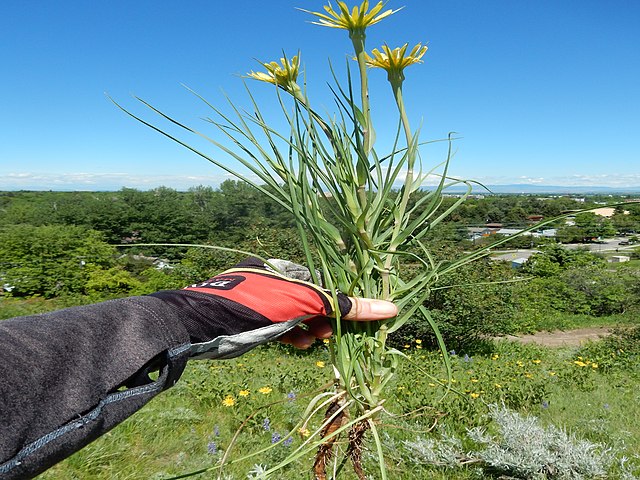
This species is native to parts of Europe and Asia and was introduced in the United States and other countries.
The yellow salsify is a monocarpic perennial, which means that the plant dies after producing flowers and seeds. It typically flowers after 2 to 4 years of life, depending on the environmental conditions. Although infrequent, it can even take more than 10 years for some plants to bloom.
The blooming period of yellow salsify usually starts in late spring and ends around mid-summer.
The inflorescences later turn into fuzzy seed heads that resemble those of dandelions but are noticeably larger (roughly the size of a tennis ball). They are botanically known as “cypselas.”
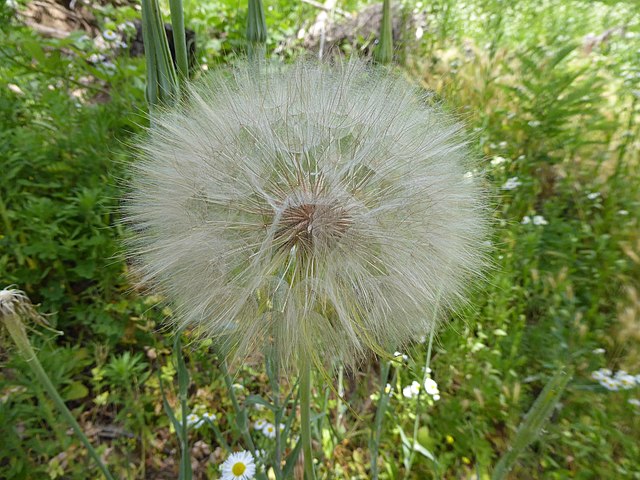
Each seed is attached to a light and fluffy structure similar to a parachute (called a pappus) which has the role of carrying the seed as far as possible from the plant.
At maturity, the seeds detach from these heads and are carried by the wind, giving birth to new plants where they land.
Tragopogon dubius usually grows up to 24 inches (60 cm) in height, but in proper conditions, particularly in richer, moister soils, the plant can grow taller.
In the first year of life, the plant only develops as an upright rosette of grass-like leaves. In the second year, it produces flowering stems. After blooming and producing seeds, the plant dies.
The stems are mostly unbranched, smooth with leaves growing alternately along their length. The leaves have a pale green color, the shape of a lance with smooth edges and pointed tips.
The roots, leaves, and stems of the plants contain a milky latex sap.
Its roots are fleshy, thick, long, and edible.
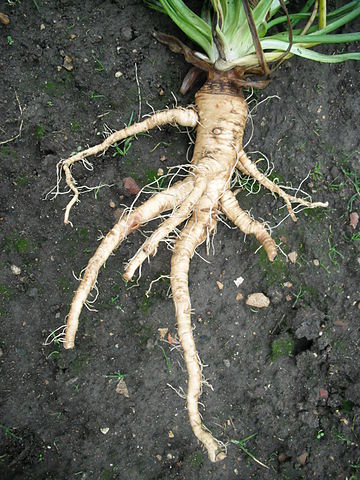
The meadow salsify (Tragopogon pratensis) is another species of salsify that produces yellow inflorescences and which may be mistaken with dandelions.
Salsify as food
Salsify roots have been consumed for centuries. According to a publication on the MSU Extension, the roots of all the salsify species found in North America are considered edible.
However, the common salsify (Tragopogon porrifolius), also known as the purple salsify or Jack go to bed, is the species that is most frequently cultivated as a vegetable and sold commercially for its parsnip-like roots.
Tragopogon porrifolius is usually identified by its purple flowers.

However, not only the roots of this plant are edible. The flower buds, leaves, and stems can be consumed as well.
Many compare the taste of the roots of cooked salsify to oysters. Hence, its common name of “oyster plant” or “vegetable oyster.”
At the same time, the consumption of this plant, especially in its raw state, has various benefits for your body.
Salsify is a good source of dietary fiber and is rich in carbs, antioxidants, vitamin C, and minerals like potassium, sodium, iron, copper, and calcium.
Parts of this plant are consumed both raw in salads and cooked as vegetables. It is often used as an ingredient in soups, or as a garnish for meat. The roots are also delicious when pickled.
These plants are also a food source for various species of animals. The flowers, seeds, and leaves are eaten by several species of wild animals, livestock, and birds.
Final Word
Salsifies are very adaptable and interesting plants, being a valuable food source since the Middle Ages both for humans and animals. Although not as popular as other vegetables, they are still cultivated for their taproots, grown as ornamental plants, or found growing wild in various areas.
Some species of salsify are sometimes confused with dandelions due to their bright yellow flowers or fluffy puffballs.
Although their inflorescences and seedheads look like giant dandelions and even share the same botanical family with dandelions (Asteraceae), salsifies are not actually true dandelions. Salsify belongs to the genus Tragopogon, while dandelion is included in the genus Taraxacum.
If you are interested in discovering more species of plants that look like dandelions but are not, we recommend that you also see this article called “5 weeds that look like dandelions.”

